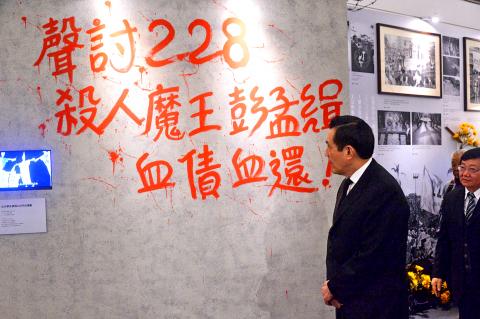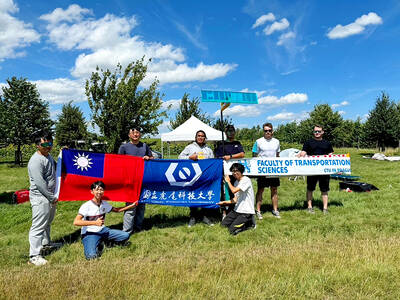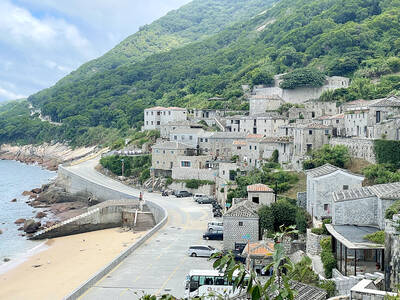Former president Ma Ying-jeou (馬英九) yesterday acknowledged Chiang Kai-shek’s (蔣介石) responsibility in the 228 Incident and the ensuing White Terror era, but said it requires deliberative rather than hasty judgement “to determine what that responsibility was.”
Ma made the remarks after completing a series of activities in Taipei to commemorate in advance the 70th anniversary of the 228 Incident, which began with him paying a tribute to a monument in the 228 Peace Memorial Park before visiting the Taipei 228 Memorial Museum and the National 228 Memorial Museum.
He was responding to reporters’ questions about the Ministry of Culture’s plans to draft a bill to reinvent the Chiang Kai-shek Memorial Hall in Taipei and pull merchandise from stores in the hall that feature Chiang’s likeness.

Photo: CNA
To have a correct understanding of Chiang, one must look at both his mistakes and accomplishments, Ma said, adding that Chiang is an important figure in modern Chinese history who had made considerable contributions to recovering, defending and building Taiwan.
“Nevertheless, as the head of state at the time, Chiang was undoubtedly liable for the 228 Incident and the White Terror era. As for exactly what kind of responsibility he had, I am afraid that is a matter for future generations to deliberate to reach a more accurate conclusion,” Ma said.
“Jumping to hasty conclusions would only create unnecessary conflicts,” he added.
The 228 Incident refers to a crackdown launched by the then-Chinese Nationalist Party (KMT) regime against civilian demonstrations following an incident in Taipei on Feb. 27, 1947.
The ensuing massacre and imposition of martial law marked the beginning of the decades-long White Terror era, during which thousands of Taiwanese were arrested, imprisoned and executed. Historians estimate as many as 30,000 people were killed.
Turning to the KMT’s past efforts to heal the wounds of the 228 Incident, Ma said it has done almost anything possible, including acknowledgment of mistakes, apologies, compensation, erection of commemorative monuments, designation of Feb. 28 as a national holiday and recovery of the truth.
“That being said, we should keep pursuing new threads and information if there are still any. This should be the attitude adopted by both the pan-blue and pan-green camps,” Ma said.
Dismissing some people’s belief that the 228 Incident was an ethnic conflict, the former president said that it was a confrontation between the government and its people triggered by the confiscation of contraband cigarettes.
“Evidence shows that in the aftermath of the incident, many Mainlanders were actually sheltered by Taiwanese,” Ma said.
As then-Taiwan governor-general Chen Yi (陳儀) was the one harshly criticized in China at the time, it suggests that “the 228 Incident was not an ethnic conflict back then and it should not be one now,” Ma said.

The Chinese military has built landing bridge ships designed to expand its amphibious options for a potential assault on Taiwan, but their combat effectiveness is limited due to their high vulnerability, a defense expert said in an analysis published on Monday. Shen Ming-shih (沈明室), a research fellow at the Institute for National Defense and Security Research, said that the deployment of such vessels as part of the Chinese People’s Liberation Army (PLA) Navy’s East Sea Fleet signals a strong focus on Taiwan. However, the ships are highly vulnerable to precision strikes, which means they could be destroyed before they achieve their intended

The Taiwan Experience Education Program (TEEP) has funded short-term internships in Taiwan for more than 4,500 young people from more than 40 countries since 2015, with the goal of attracting and retaining international talent, the Ministry of Education said yesterday. Fifty-five colleges launched 514 projects this year, including in fields such as semiconductors, artificial intelligence, medicine and biotechnology, green energy, and sustainability, it said. The program provides research and practical internships in Taiwan for two to six months, and offers cultural exchange and networking opportunities, the ministry said. For example, National Formosa University’s Embedded System and Autopilot Laboratory developed two solar-powered drones in

GLOBAL: Although Matsu has limited capacity for large numbers of domestic tourists, it would be a great high-end destination for international travelers, an official said Lienchiang County’s (Matsu) unique landscape and Cold War history give it great potential to be marketed as a destination for international travelers, Tourism Administration Director General Chen Yu-hsiu (陳玉秀) said at the weekend. Tourism officials traveled to the outlying island for the Matsu Biennial, an art festival that started on Friday to celebrate Matsu’s culture, history and landscape. Travelers to Matsu, which lies about 190km northwest of Taipei, must fly or take the state-run New Taima passenger ship. However, flights are often canceled during fog season from April to June. Chen spoke about her vision to promote Matsu as a tourist attraction in

Taipei resident Mu Chu-hua caught some glimpses of China’s mighty military parade on YouTube on Wednesday. As she watched hypersonic missiles roll down Beijing’s Changan Avenue and troops march in lockstep, she did not feel like they posed a threat to Taiwan. Mu, a 69-year-old retiree, said she saw the parade as simply a way for Chinese President Xi Jinping (習近平) to “say thank you to the troops.” “I thought it was quite normal,” she said. “It was very cool.” China’s military parade commemorating the end of World War II was being watched internationally for insights into Beijing’s military advances and its show